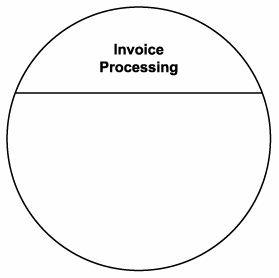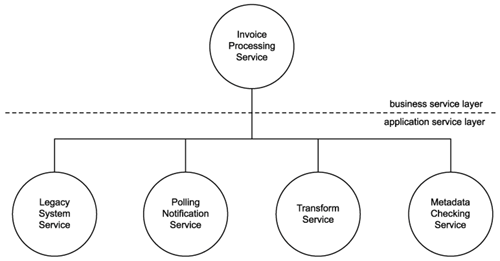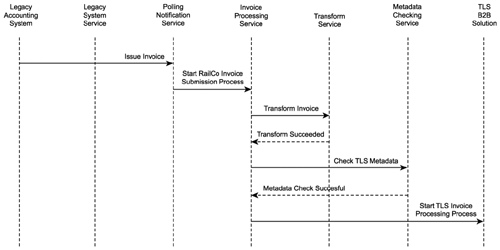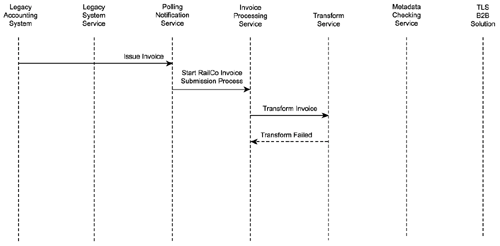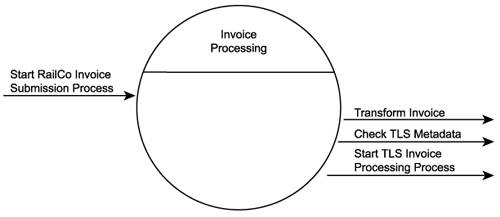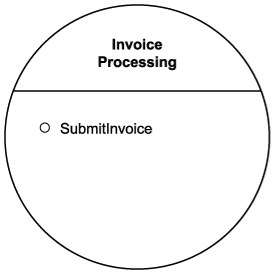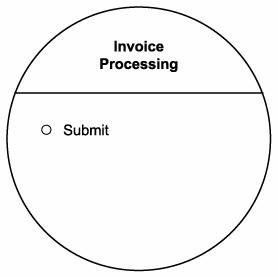Task-centric business service design (a step-by-step process)
The process for designing task-centric services usually require less effort than the previous two design processes, simply because reuse is generally not a primary consideration. Therefore, only the service operation candidates identified as part of the service modeling process are addressed here.
Figure 15.15. Task-centric business services can comprise the business service layer, along with entity-centric neighbors.
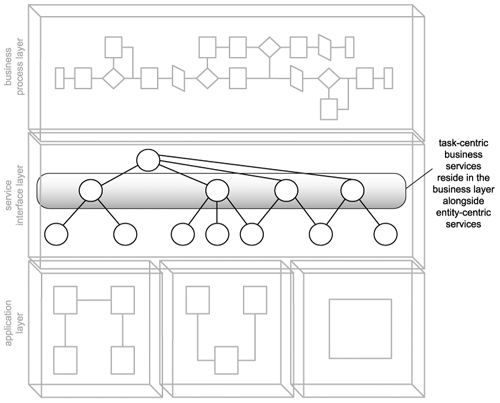
15.4.1. Process description
As shown in Figure 15.16, this process starts off with a new kind of step in which workflow logic is mapped out. This is because task-centric business services are expected to contain and govern portions of business processes.
Figure 15.16. The task-centric business service design process.
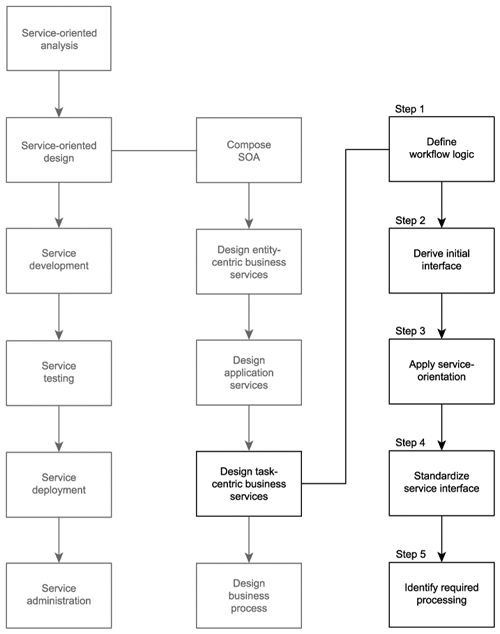
Note that there is no step encouraging you to extend the service design beyond the feature set you already defined in the service modeling stage. As previously mentioned, providing a generic and reusable interface is not a priority for task-centric services.
Time now to begin our service design.
Step 1: Define the workflow logic
Task-centric services typically will contain embedded workflow logic used to coordinate an underlying service composition. Our first step, therefore, is to define this logic for every possible interaction scenario we can imagine. If you performed the mapping exercise in the Identify candidate service compositions step of the service modeling process in Chapter 12, then you will have preliminary composition details already documented.
Because we are designing our task-centric business service after our entity-centric and application service designs have been completed, we will need to revisit these scenario documents and turn them into concrete service interaction models.
Different traditional modeling approaches can be used to accomplish this step (we use simple activity diagrams in our case study examples). The purpose of this exercise is to document each possible execution path, including all exception conditions. The resulting diagrams also will be useful input for subsequent test cases.
Note
The workflow logic does not reside in the service interface we are designing in this process. We are defining workflow logic for the purpose of extracting the message exchanges with which this service will be involved. This provides us with information that helps us define types, operations, and message formats.
Step 2: Derive the service interface
Follow these suggested steps to assemble an initial service interface:
|
1. |
Use the application service operation candidates to derive a set of corresponding operations. |
|
2. |
Unlike previous design processes, the source from which we derive our service interface this time also includes the activity diagrams and the workflow logic we documented in Step 1. This information gives us a good idea as to what additional operations our task-centric service may require. |
|
3. |
Document the input and output values required for the processing of each operation and populate the types section with XSD schema types required to process the operations. |
|
4. |
Build the WSDL definition by creating the portType (or interface) area, inserting the identified operation constructs. Then add the necessary message constructs containing the part elements that reference the appropriate schema types. |
Step 3: Apply principles of service-orientation
Before we get too far ahead in our service design, it is beneficial to take another look at the four service-orientation principles we covered in Chapter 8, which are not automatically provided to us through the use of Web services (service reusability, service autonomy, service statelessness, and service discoverability).
Reuse opportunities for task-centric services are much more rare than for entity-centric and application services. This is because task-centric services represent a portion of workflow logic specific to a business process. However, reuse still can be achieved. The Take into account the potential cross-process reusability of the logic being encapsulated and Consider the potential intra-process reusability of the logic being encapsulated modeling guidelines in Chapter 12 address this and still are applicable to this process.
Because they almost always act as parent controller services in compositions, the autonomy of task-centric services is generally dependent on the autonomy of the underlying child services. A consistent state of autonomy can therefore be challenging to maintain.
Task-centric services contain workflow logic that may impose processing dependencies in service compositions. This can lead to the need for state management. However, the use of document-style SOAP messages allows the service to delegate the persistence of some or all of this state information to the message itself.
It is always useful for services to be discoverable, but the need for task-centric services to be discovered is not as pressing as with other, more generically reusable services. Regardless, task-centric services can achieve reuse, and their existence should be known to others. Therefore, the Document services with metadata guideline provided at the end of this chapter also is recommended.
Step 4: Standardize and refine the service interface
Although task-centric business services will tend to have more creative operation names, existing conventions still need to be applied. Here is the standard list of recommended actions you can take to achieve a standardized and streamlined service design:
- Incorporate existing design standards and guidelines. (A set of recommended guidelines is provided at the end of this chapter.)
- Ensure that any chosen contemporary SOA characteristics are fully supported by the service interface design.
- Take WS-I Basic Profile standards and best practices into account.
With regard to design standards relating to operation granularity, some leniency may be required to accommodate the processing of the service's embedded workflow sequence logic. Also, task-centric business services can benefit from reusing existing WSDL modules, in particular, XSD schema definitions.
Step 5: Identify required processing
To carry out their share of a solution's process logic, task-centric services can compose application and both entity-centric and additional task-centric business services. Therefore, the implementation of a task-centric service interface requires that any needed underlying service layers are in place to support the processing requirements of its operations.
Because this is the last of our three service design processes, all required supporting aplication services need to be identified. They may consist of services that already existed and/or services we just designed during the previous application service design process. The design of process logic within the task-centric business service may also reveal the need for additional application services that haven't yet been considered.
|
SUMMARY OF KEY POINTS |
|---|
|
Introduction
- Why this book is important
- Objectives of this book
- Who this book is for
- What this book does not cover
- How this book is organized
- Additional information
Case Studies
- Case Studies
- How case studies are used
- Case #1 background: RailCo Ltd.
- Case #2 background: Transit Line Systems Inc.
Part I: SOA and Web Services Fundamentals
Introducing SOA
- Introducing SOA
- Fundamental SOA
- Common characteristics of contemporary SOA
- Common misperceptions about SOA
- Common tangible benefits of SOA
- Common pitfalls of adopting SOA
The Evolution of SOA
- The Evolution of SOA
- An SOA timeline (from XML to Web services to SOA)
- The continuing evolution of SOA (standards organizations and contributing vendors)
- The roots of SOA (comparing SOA to past architectures)
Web Services and Primitive SOA
- Web Services and Primitive SOA
- The Web services framework
- Services (as Web services)
- Service descriptions (with WSDL)
- Messaging (with SOAP)
Part II: SOA and WS-* Extensions
Web Services and Contemporary SOA (Part I: Activity Management and Composition)
- Web Services and Contemporary SOA (Part I: Activity Management and Composition)
- Message exchange patterns
- Service activity
- Coordination
- Atomic transactions
- Business activities
- Orchestration
- Choreography
Web Services and Contemporary SOA (Part II: Advanced Messaging, Metadata, and Security)
- Web Services and Contemporary SOA (Part II: Advanced Messaging, Metadata, and Security)
- Addressing
- Reliable messaging
- Correlation
- Policies
- Metadata exchange
- Security
- Notification and eventing
Part III: SOA and Service-Orientation
Principles of Service-Orientation
- Principles of Service-Orientation
- Service-orientation and the enterprise
- Anatomy of a service-oriented architecture
- Common principles of service-orientation
- How service-orientation principles inter-relate
- Service-orientation and object-orientation (Part II)
- Native Web service support for service-orientation principles
Service Layers
- Service Layers
- Service-orientation and contemporary SOA
- Service layer abstraction
- Application service layer
- Business service layer
- Orchestration service layer
- Agnostic services
- Service layer configuration scenarios
Part IV: Building SOA (Planning and Analysis)
SOA Delivery Strategies
- SOA Delivery Strategies
- SOA delivery lifecycle phases
- The top-down strategy
- The bottom-up strategy
- The agile strategy
Service-Oriented Analysis (Part I: Introduction)
- Service-Oriented Analysis (Part I: Introduction)
- Service-oriented architecture vs. Service-oriented environment
- Introduction to service-oriented analysis
- Benefits of a business-centric SOA
- Deriving business services
Service-Oriented Analysis (Part II: Service Modeling)
- Service-Oriented Analysis (Part II: Service Modeling)
- Service modeling (a step-by-step process)
- Service modeling guidelines
- Classifying service model logic
- Contrasting service modeling approaches (an example)
Part V: Building SOA (Technology and Design)
Service-Oriented Design (Part I: Introduction)
- Service-Oriented Design (Part I: Introduction)
- Introduction to service-oriented design
- WSDL-related XML Schema language basics
- WSDL language basics
- SOAP language basics
- Service interface design tools
Service-Oriented Design (Part II: SOA Composition Guidelines)
- Service-Oriented Design (Part II: SOA Composition Guidelines)
- Steps to composing SOA
- Considerations for choosing service layers
- Considerations for positioning core SOA standards
- Considerations for choosing SOA extensions
Service-Oriented Design (Part III: Service Design)
- Service-Oriented Design (Part III: Service Design)
- Service design overview
- Entity-centric business service design (a step-by-step process)
- Application service design (a step-by-step process)
- Task-centric business service design (a step-by-step process)
- Service design guidelines
Service-Oriented Design (Part IV: Business Process Design)
- Service-Oriented Design (Part IV: Business Process Design)
- WS-BPEL language basics
- WS-Coordination overview
- Service-oriented business process design (a step-by-step process)
Fundamental WS-* Extensions
- Fundamental WS-* Extensions
- You mustUnderstand this
- WS-Addressing language basics
- WS-ReliableMessaging language basics
- WS-Policy language basics
- WS-MetadataExchange language basics
- WS-Security language basics
SOA Platforms
Appendix A. Case Studies: Conclusion
EAN: 2147483647
Pages: 150
